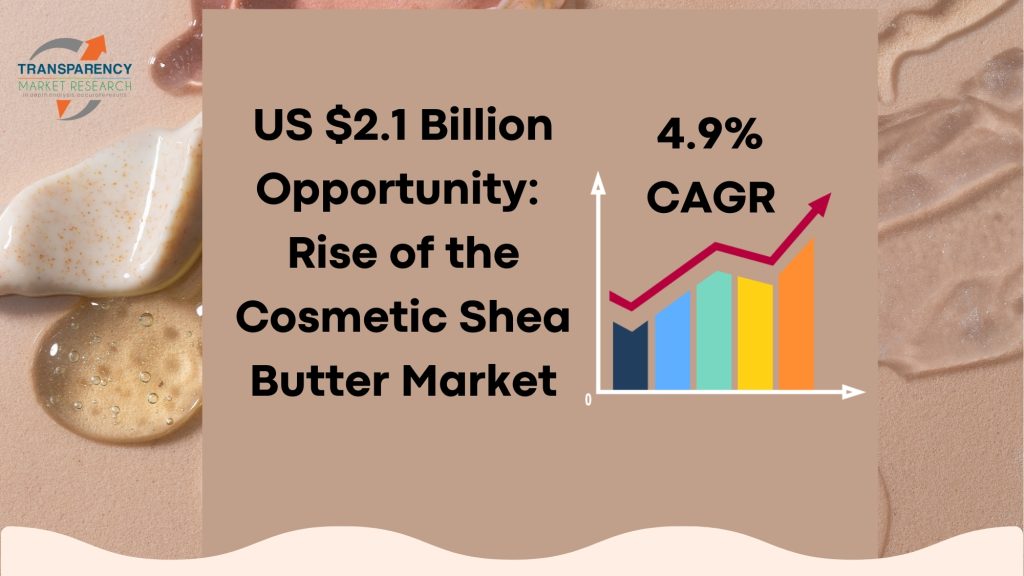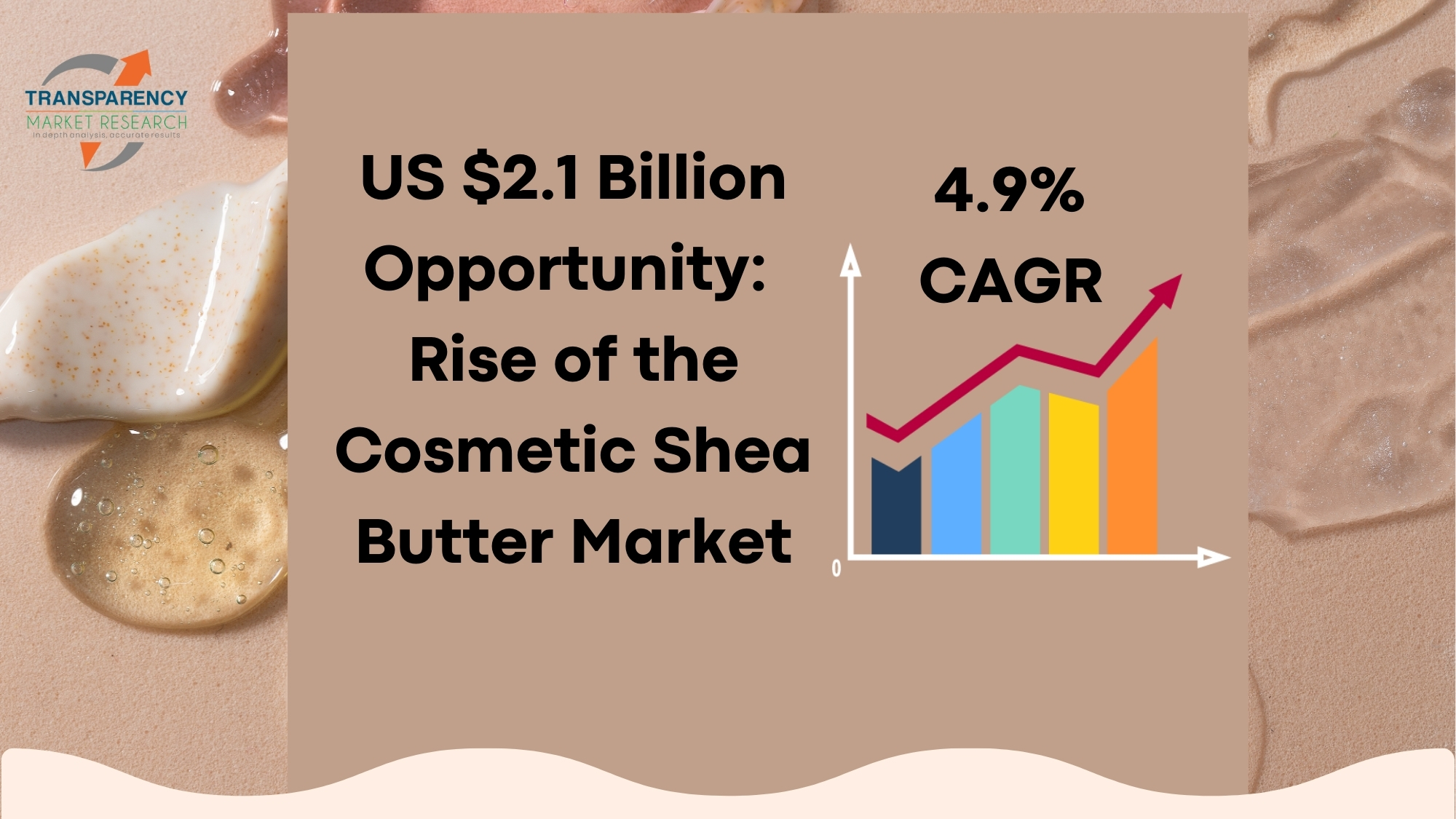
Wilmington, Delaware, Transparency Market Research Inc. –, Jan. 23, 2025 (GLOBE NEWSWIRE) — The global cosmetic shea butter market, once just a niche segment, has now garnered substantial attention. As of 2022, the market was valued at US$ 1.4 billion, and it is set on a promising trajectory with a projected growth rate of 4.9% CAGR from 2023 to 2031. By the end of this forecast period, the market is expected to achieve an impressive valuation of US$ 2.1 billion.
Rise of Anti-Aging Solutions
One of the primary drivers behind this robust market growth is the burgeoning demand for anti-aging ingredients in cosmetic products. Anti-aging solutions target the reduction or prevention of visible signs of aging such as fine lines, wrinkles, and age spots. They often contain powerful ingredients designed to rejuvenate and revitalize the skin. Shea butter, renowned for its rich moisturizing and nourishing properties, has become a cornerstone in these formulations.
Consumers’ desire to retain youthful skin is a major factor pushing the demand for anti-aging products. The modern obsession with beauty and youthfulness is not just a cultural trend but a global phenomenon. Social media platforms, with their ever-growing influence, have played a significant role in amplifying this trend. Beauty influencers and skincare enthusiasts regularly highlight the benefits of natural ingredients like shea butter, making them highly coveted in the cosmetic industry.
Request a Detailed PDF Brochure – https://www.transparencymarketresearch.com/sample/sample.php?flag=S&rep_id=55656

Market Dynamics and Key Influencers
Several factors are shaping the landscape of the cosmetic shea butter market:
- Youthful Appearance: The universal desire to maintain youthful skin is a potent driver. Shea butter, with its high content of vitamins and fatty acids, is celebrated for its ability to nourish and hydrate the skin, making it a preferred ingredient in many anti-aging products.
- Digital Influence: Social media has revolutionized the way consumers discover and purchase beauty products. Platforms such as Instagram, YouTube, and TikTok are teeming with influencers who advocate for the use of natural and organic skincare ingredients. This digital endorsement significantly boosts the popularity of shea butter in cosmetics.
- Aging Demographics: The global population is aging, and the demand for effective anti-aging products is on the rise. Shea butter’s properties, including its ability to moisturize deeply and reduce inflammation, make it an ideal choice for older consumers looking for reliable skincare solutions.
Key Companies-
Key players in the global cosmetic shea butter market segment – e.g., specialty fats market, shea butter market] include Cargill, Incorporated, Clariant AG, AAK AB, Olvea Group, Archer Daniels Midland Company, Bunge Limited, BASF SE, Croda International Plc, Ghana Nuts Company Ltd, Agrobotanicals, LLC, Sophim S.A., AOS Products Private Limited, The Savannah Fruits Company, Ojoba Collective, and The HallStar Company.
Recent Developments:
- 2022:
- Bunge Loders Croklaan launched Karibon, a 100% shea-based premium Cocoa Butter Equivalent (CBE), expanding shea butter applications beyond traditional cosmetics.
- 2021:
- Fuji Oil Group established the Responsible Shea Kernels Sourcing Policy, emphasizing sustainable and ethical sourcing practices within the shea butter supply chain.
- Ongoing:
- Companies like Isivuno Naturals and FirstSeed Organics in South Africa are focusing on producing high-quality, unrefined shea butter to cater to the growing demand for natural and organic ingredients in cosmetics.
Innovative Trends in the Market
As the market continues to evolve, several key trends are emerging that are likely to shape its future:
- E-commerce Boom: The rise of e-commerce has transformed the cosmetic industry, making it easier for consumers to access a wide range of products. Online platforms offer personalized marketing and seamless browsing experiences, broadening the reach of shea butter-based cosmetics.
- Sustainable Sourcing: Today’s consumers are increasingly concerned about the ethical sourcing of ingredients. Companies are responding by adopting sustainable and fair-trade practices in their shea butter procurement processes. This commitment to ethical sourcing not only appeals to conscious consumers but also fosters long-term sustainability in the industry.
- Product Diversification: Innovation is at the heart of the cosmetic industry. Manufacturers are continuously developing new and diverse products that incorporate shea butter. From creams and lotions to serums and masks, these products cater to various skincare needs and preferences, ensuring that consumers have a wide array of choices.
Get Customized Insights & Analysis for Your Business Needs: https://www.transparencymarketresearch.com/sample/sample.php?flag=S&rep_id=55656
Market Segmentation
- By Nature:
- By Grade:
- Grade A (Unrefined)
- Grade B (Refined)
- Grade C (Highly Refined)
- By End-use:
- Lotions & Creams
- Lip Balms & Lipsticks
- Sun Care Products
- Soaps & Toiletries
- Cleansers
- Shampoos & Conditioners
- Others
- Regions Covered:
- North America
- Latin America
- Europe
- Asia Pacific
- Middle East & Africa
Future Outlook
Looking ahead, the cosmetic shea butter market is poised for significant growth. The increasing demand for anti-aging ingredients, coupled with the influence of social media beauty trends, will continue to drive market expansion. Companies are expected to invest heavily in product innovation, creating new formulations that harness the full potential of shea butter.
Furthermore, the emphasis on sustainable and ethical sourcing will likely become even more pronounced. Consumers are becoming more discerning about the origin of the ingredients in their skincare products, and companies that prioritize transparency and sustainability are likely to gain a competitive edge.
In conclusion, the cosmetic shea butter market is on an upward trajectory, fueled by the relentless pursuit of youthful beauty and the growing popularity of natural skincare ingredients. With a projected market value of US$ 2.1 billion by 2031, the future looks bright for this versatile and much-loved ingredient.
Buy This Premium Research Report Now to Get Detailed Analysis: https://www.transparencymarketresearch.com/checkout.php?rep_id=55656<ype=S
Explore Latest Research Reports by Transparency Market Research:
- Food Grade Iron Powder Market – Expected to grow at a CAGR of 5.7% from 2023 to 2031 and reach US$ 8.9 Billion by the end of 2031
- Palatants Market – Estimated to grow at a CAGR of 5.1% from 2023 to 2031 and reach US$ 4.6 Billion by the end of 2031.
About Transparency Market Research
Transparency Market Research, a global market research company registered at Wilmington, Delaware, United States, provides custom research and consulting services. Our exclusive blend of quantitative forecasting and trends analysis provides forward-looking insights for thousands of decision makers. Our experienced team of Analysts, Researchers, and Consultants use proprietary data sources and various tools & techniques to gather and analyses information.
Our data repository is continuously updated and revised by a team of research experts, so that it always reflects the latest trends and information. With a broad research and analysis capability, Transparency Market Research employs rigorous primary and secondary research techniques in developing distinctive data sets and research material for business reports.
Contact:
Transparency Market Research Inc.
CORPORATE HEADQUARTER DOWNTOWN,
1000 N. West Street,
Suite 1200, Wilmington, Delaware 19801 USA
Tel: +1-518-618-1030
USA – Canada Toll Free: 866-552-3453
Website: https://www.transparencymarketresearch.com
Email: sales@transparencymarketresearch.com
Follow Us: LinkedIn| Twitter| Blog | YouTube

© 2025 Benzinga.com. Benzinga does not provide investment advice. All rights reserved.

